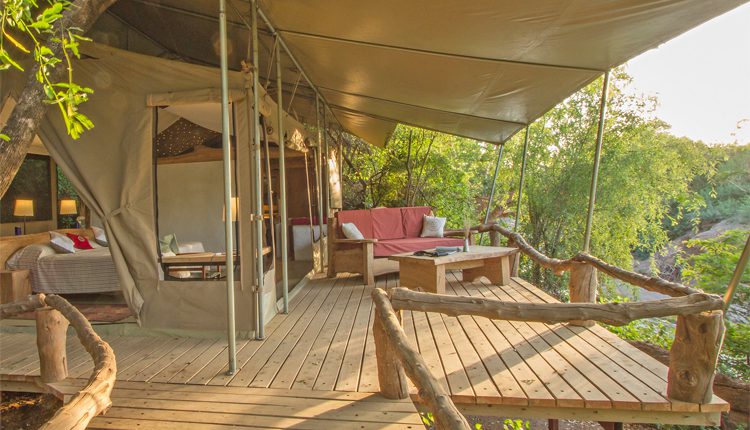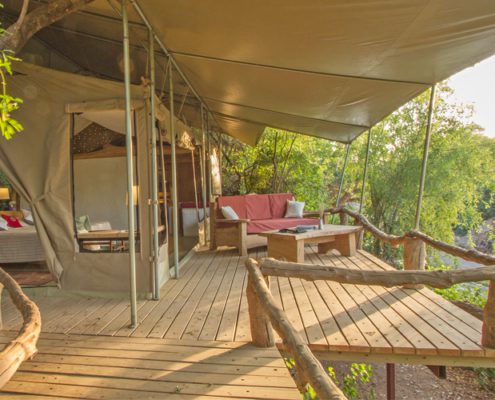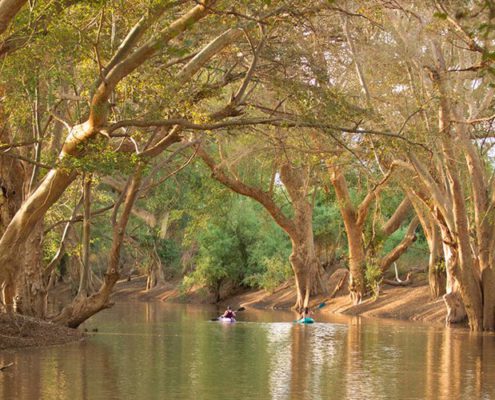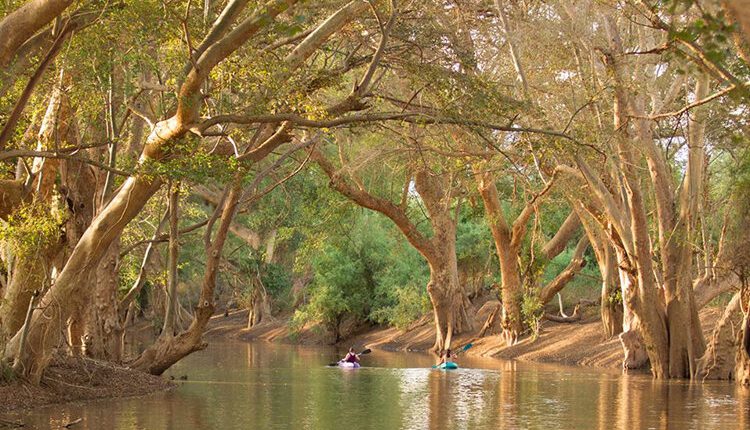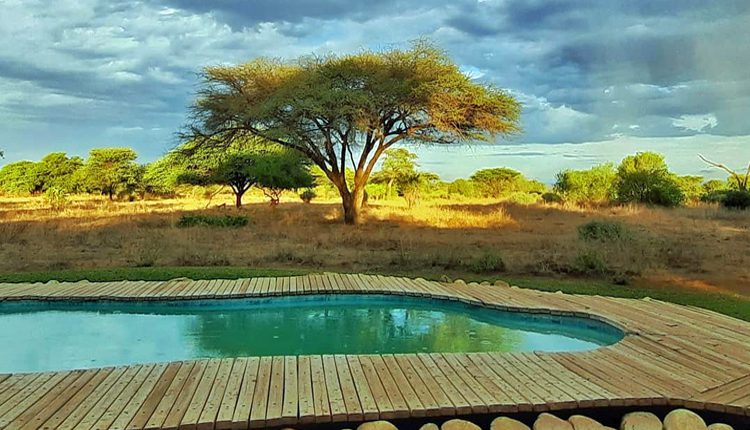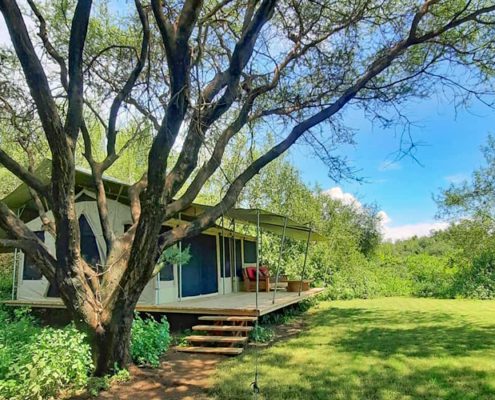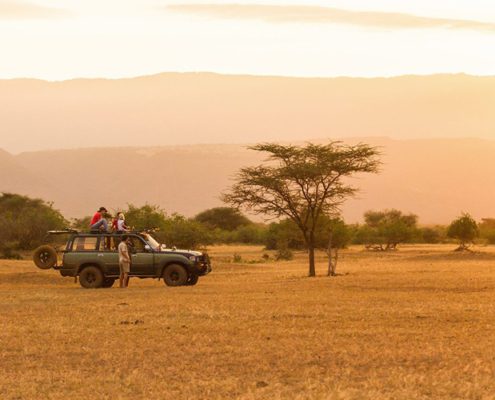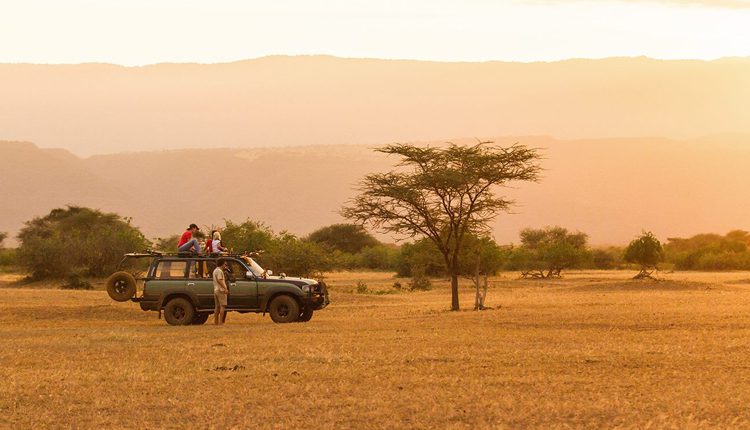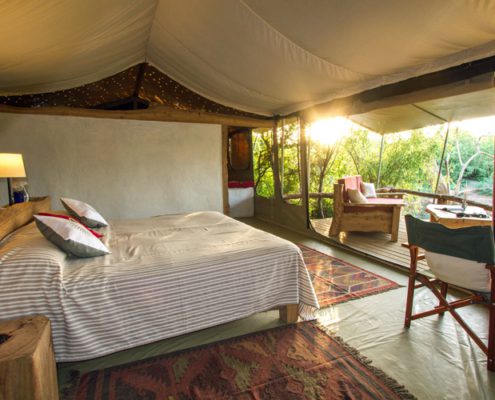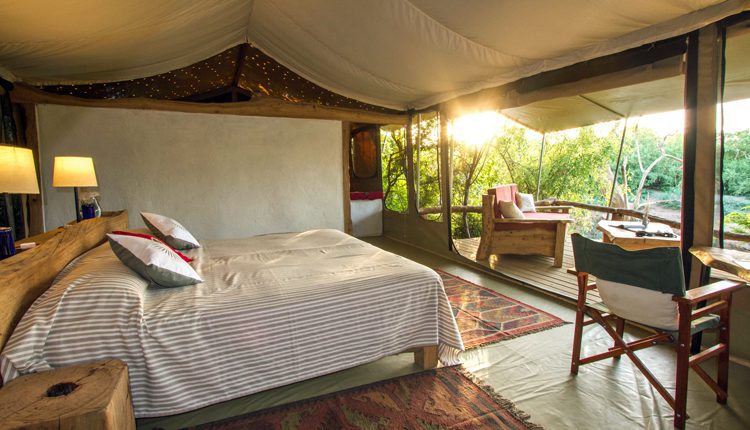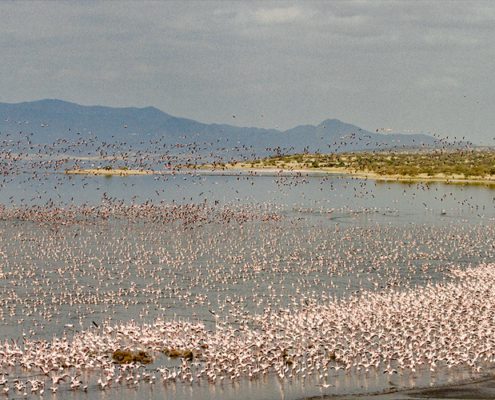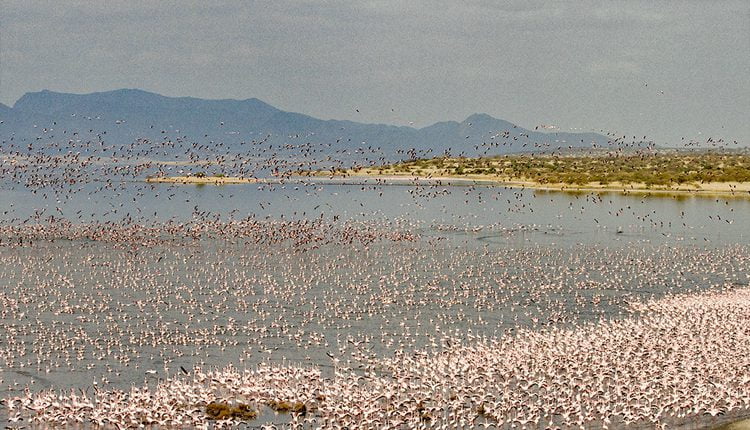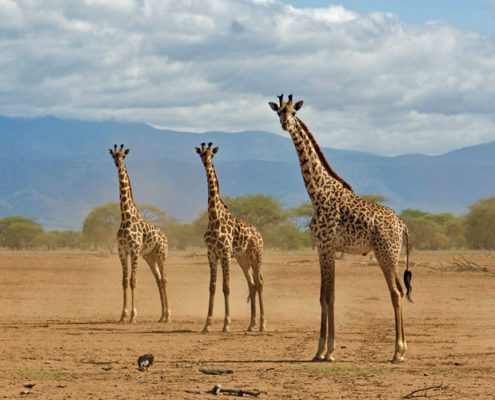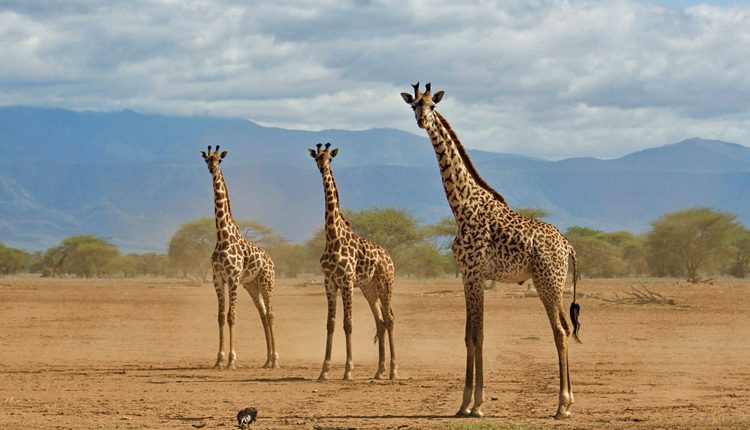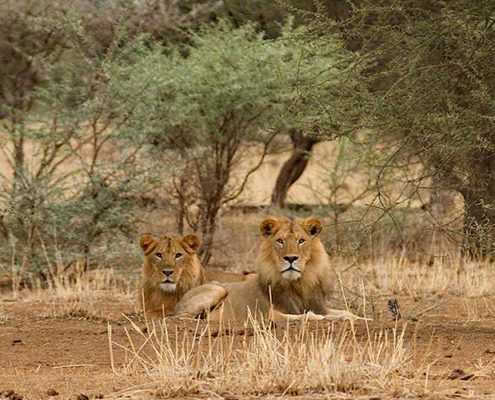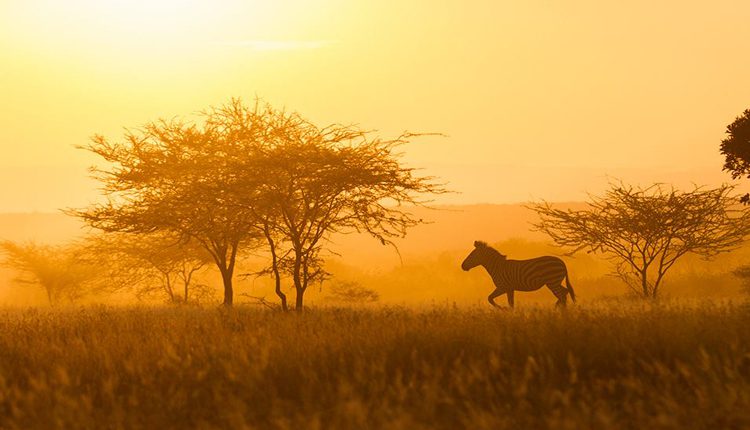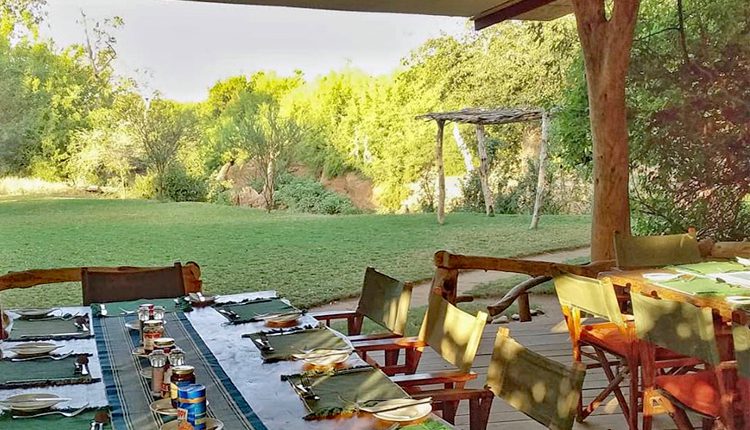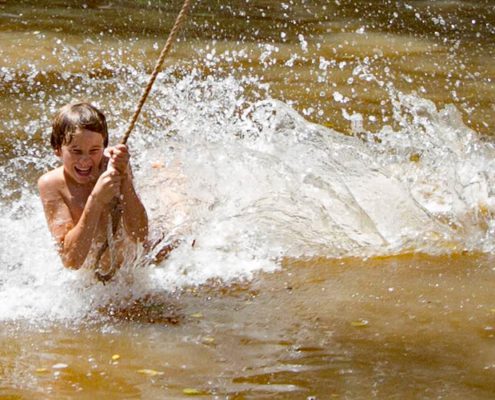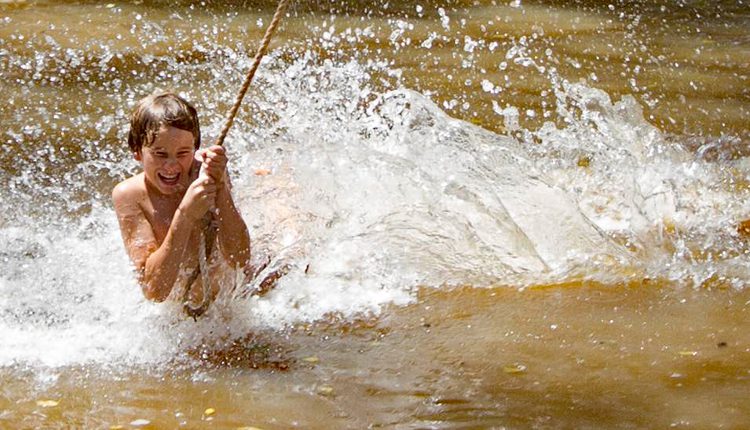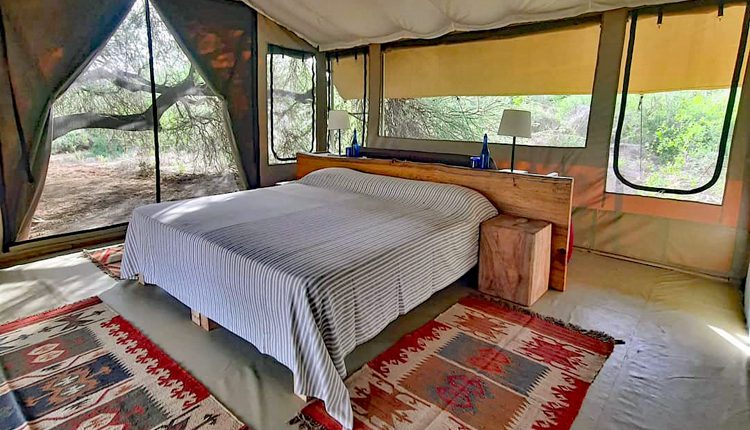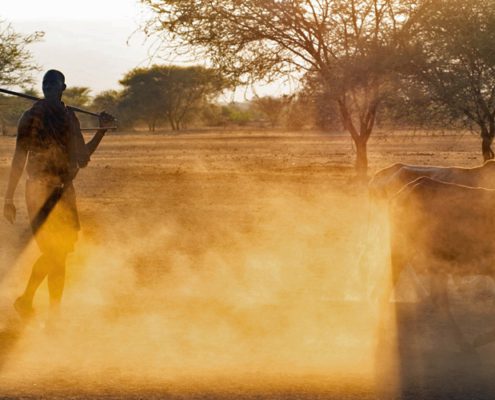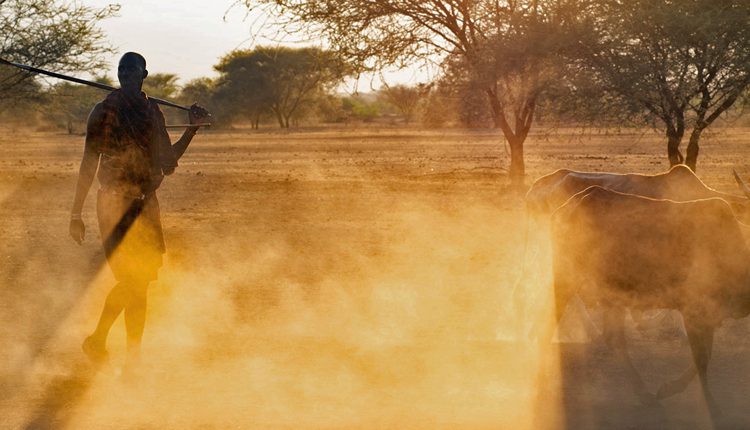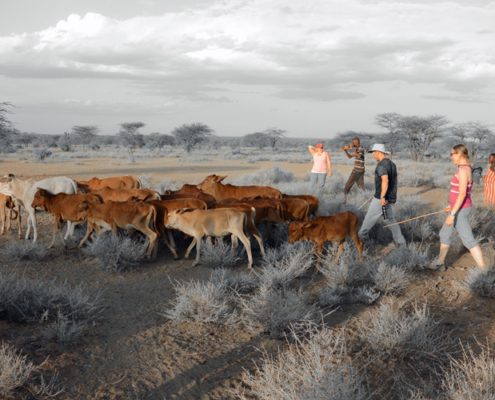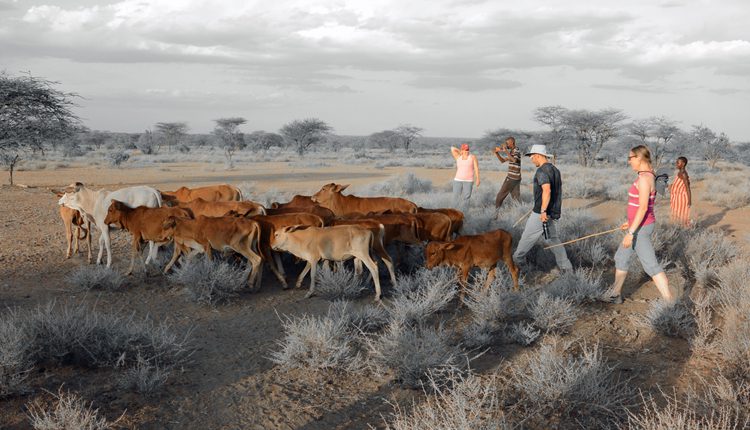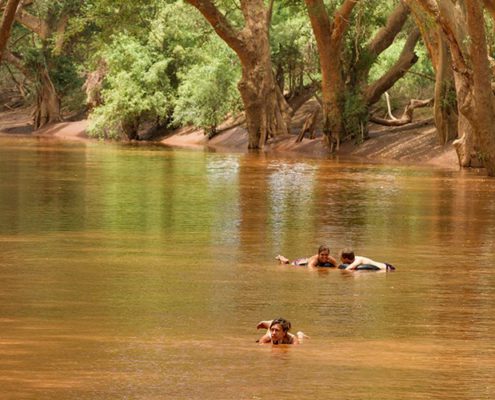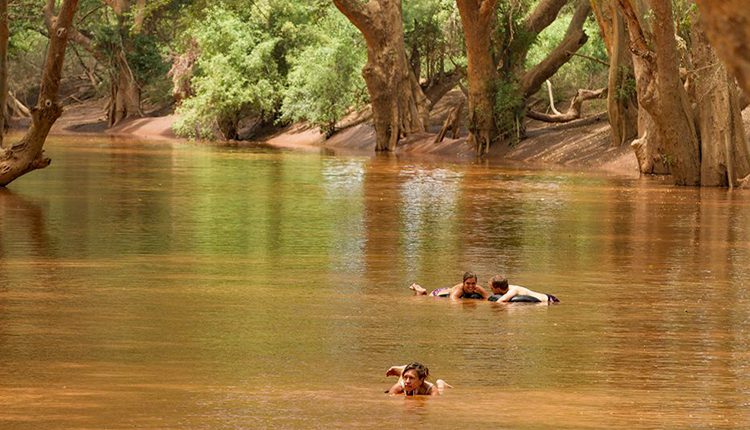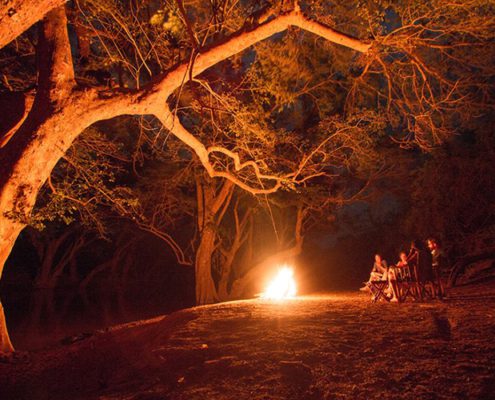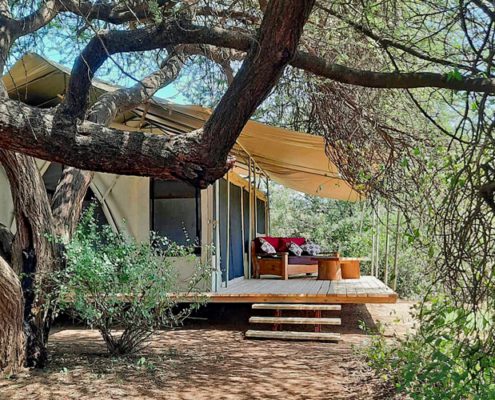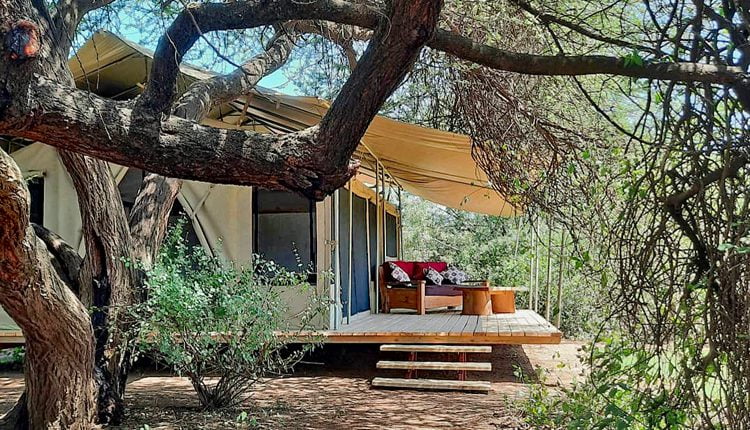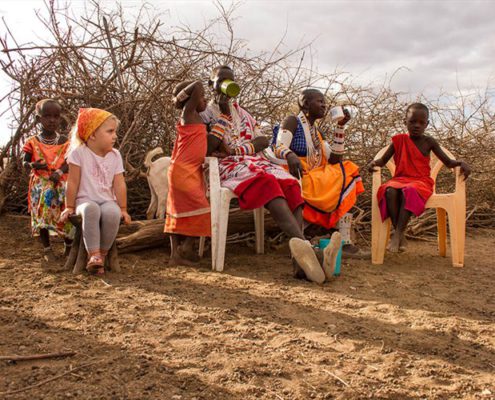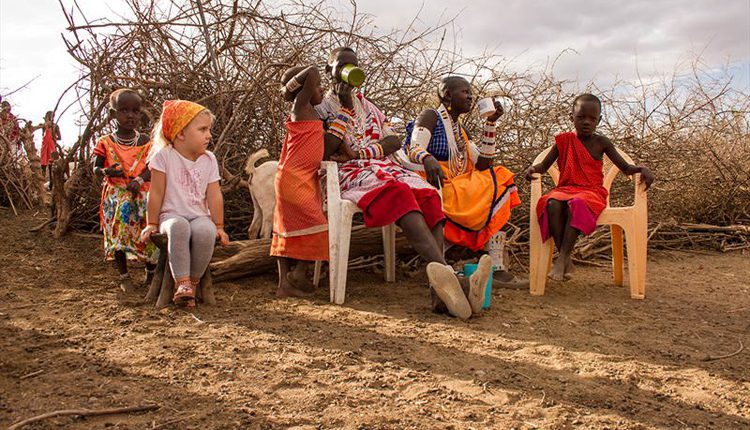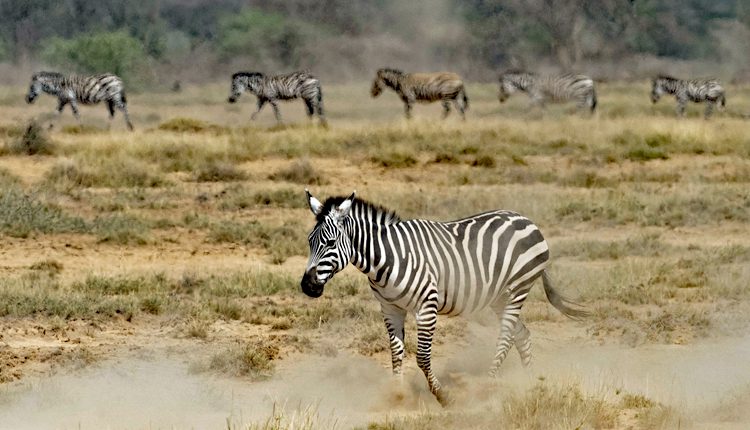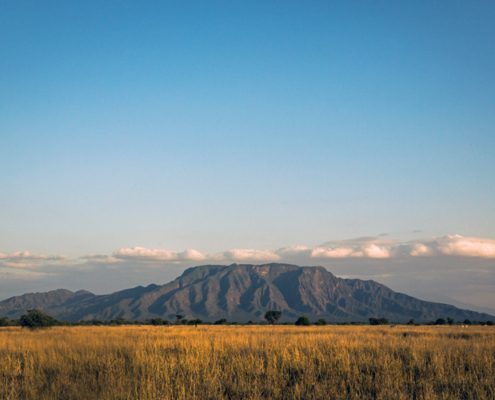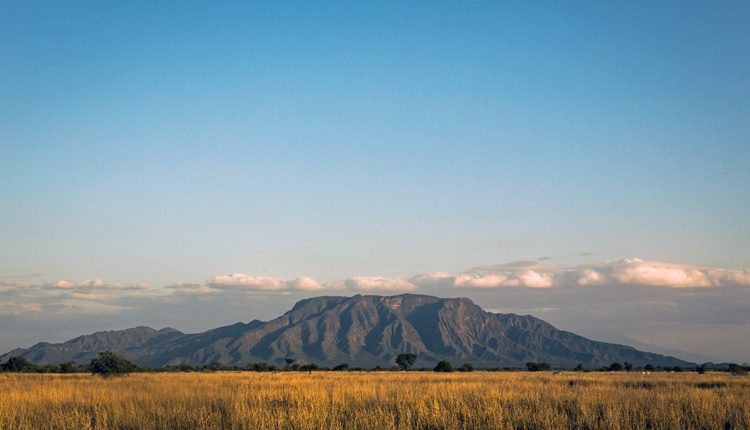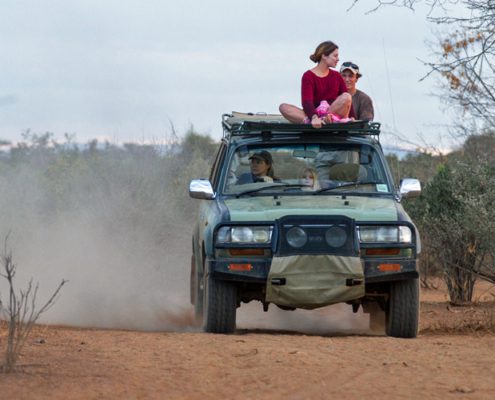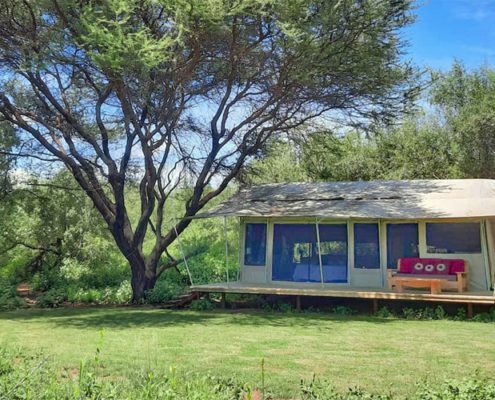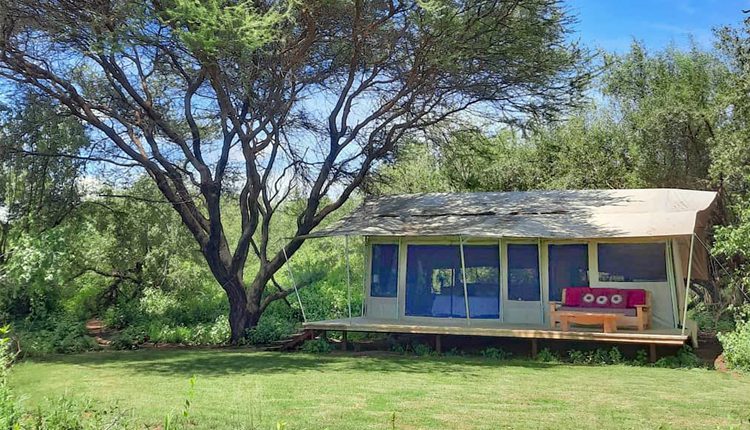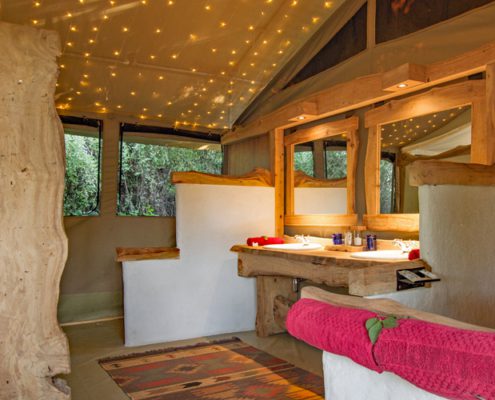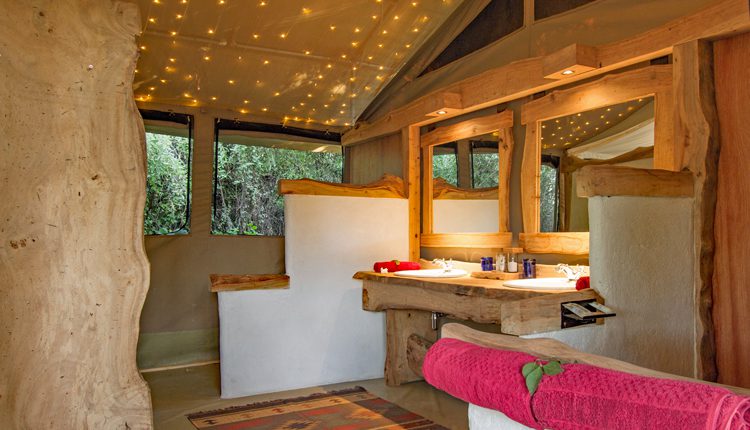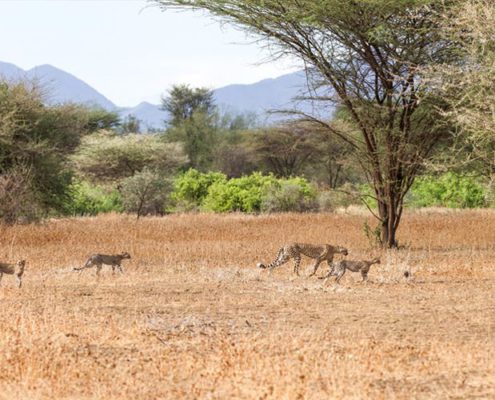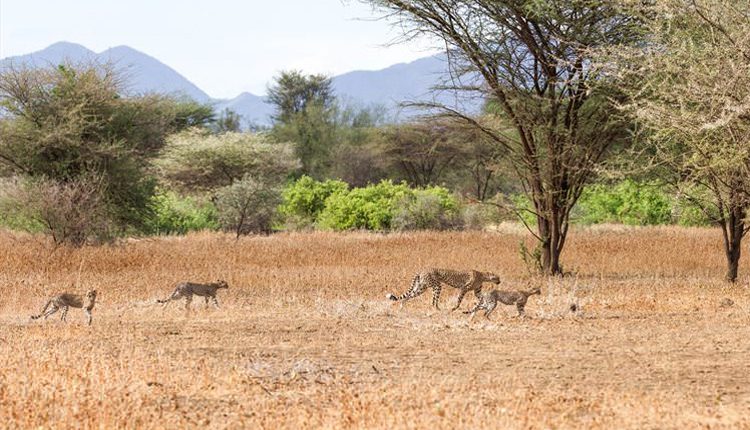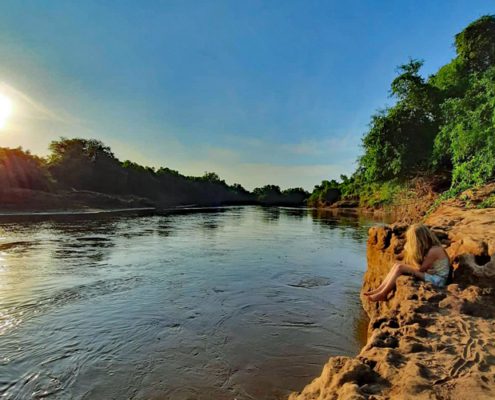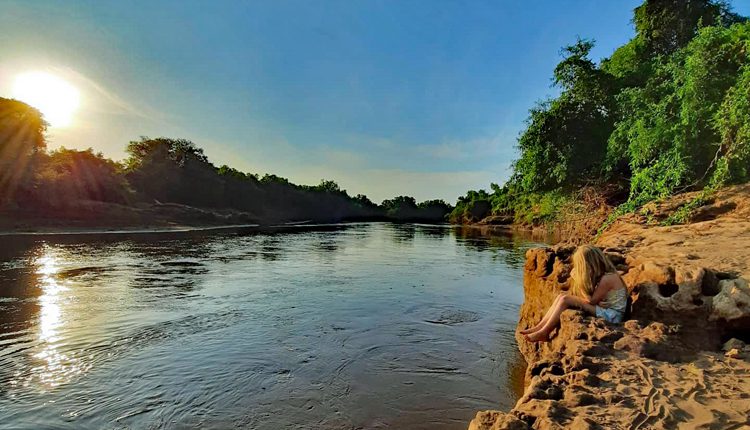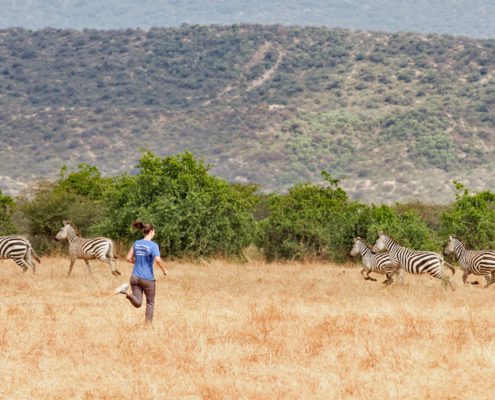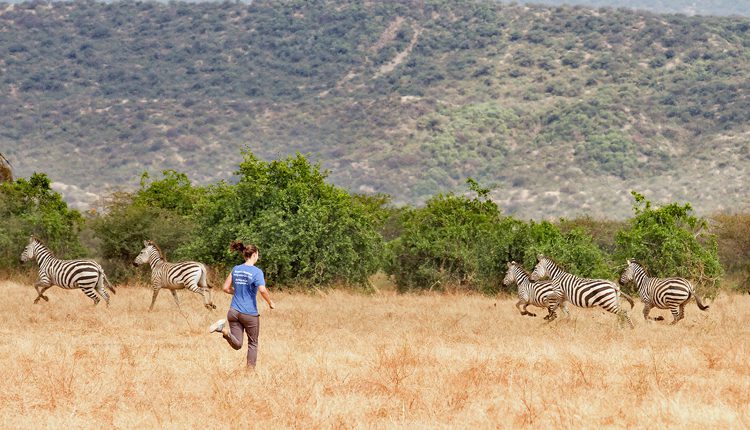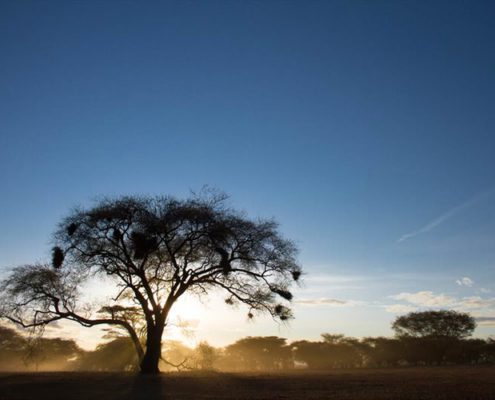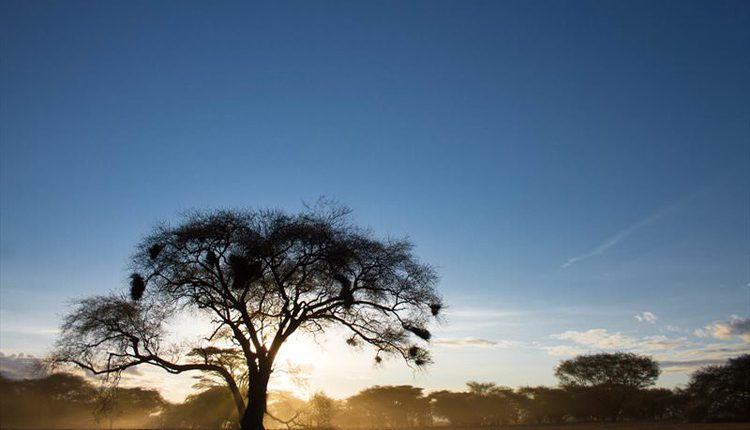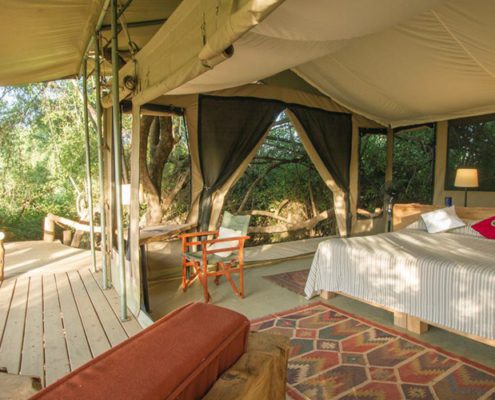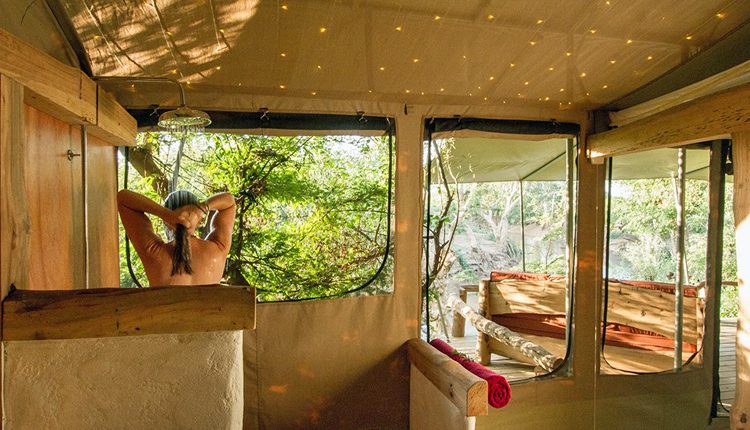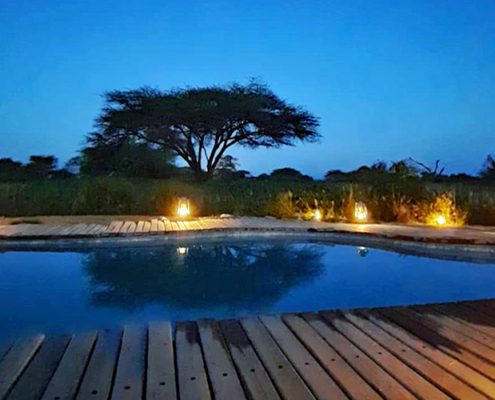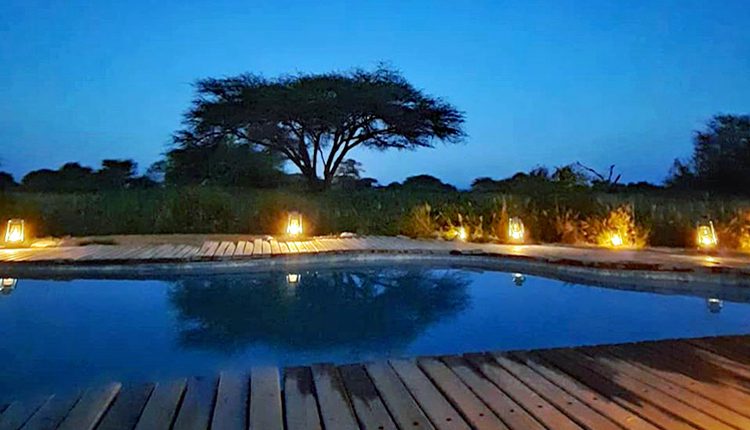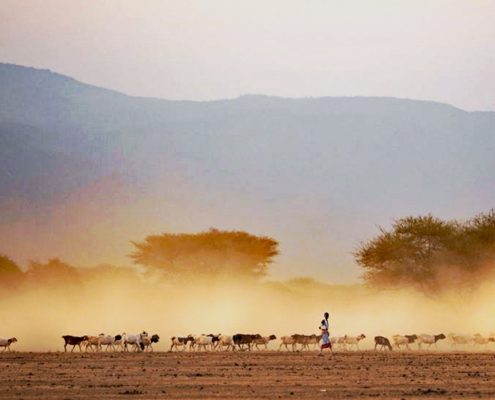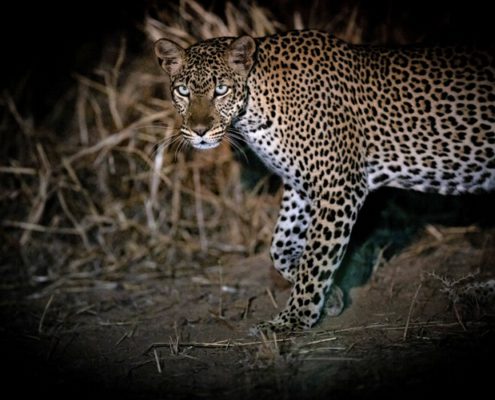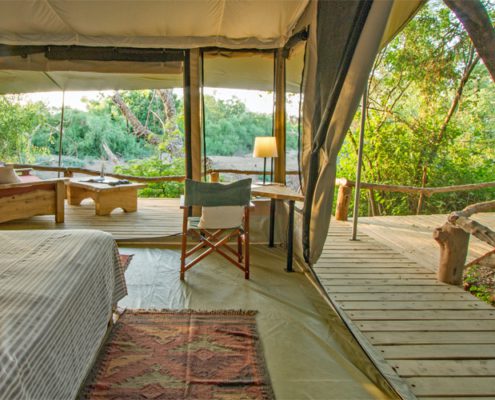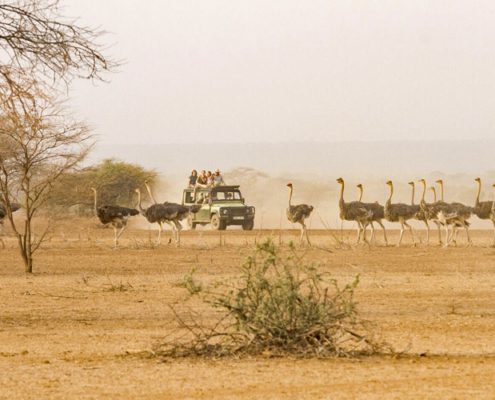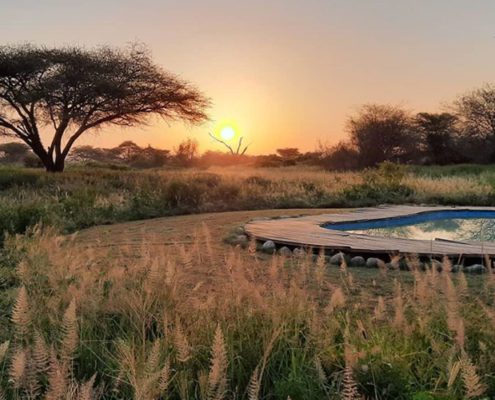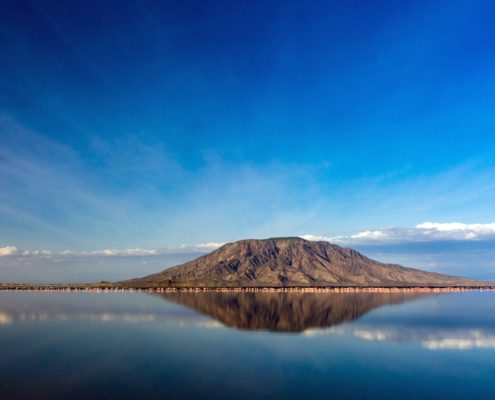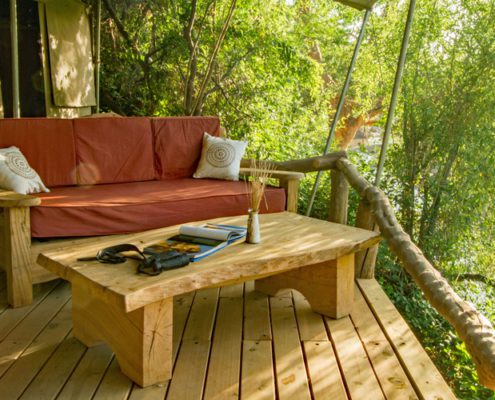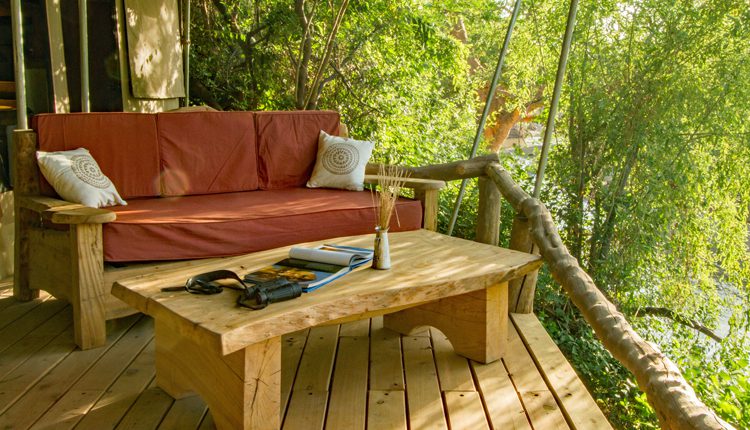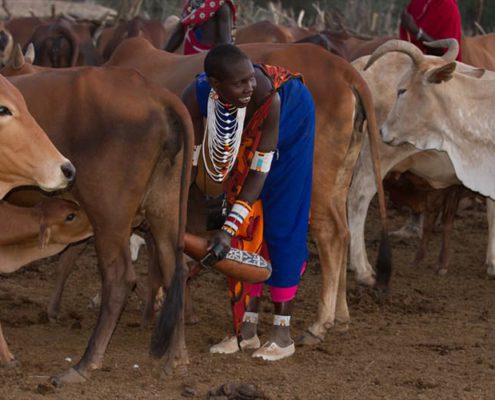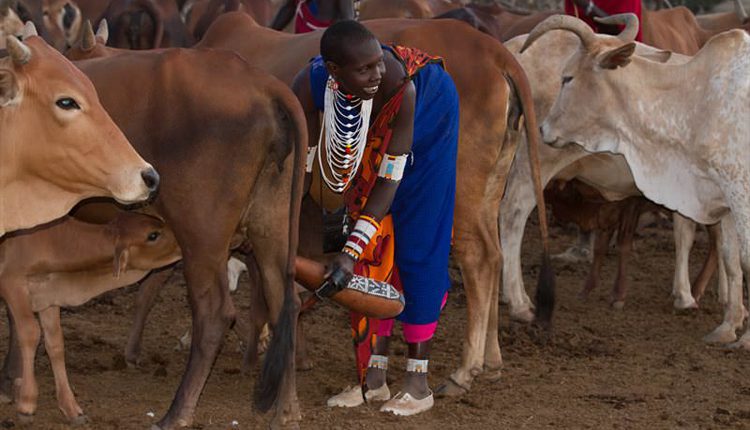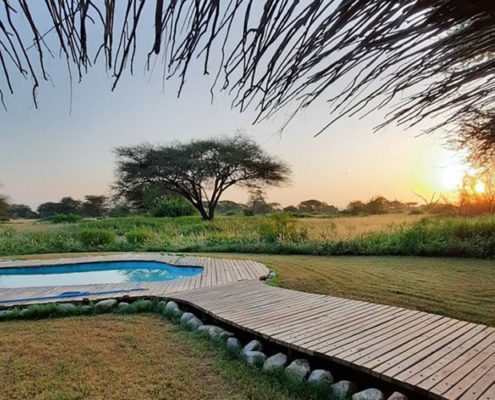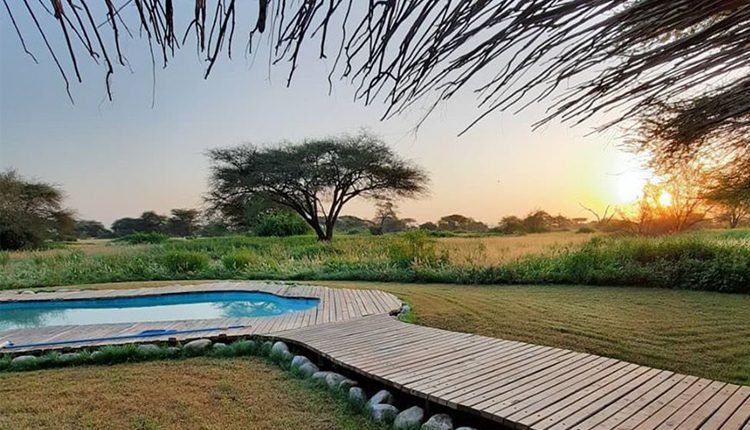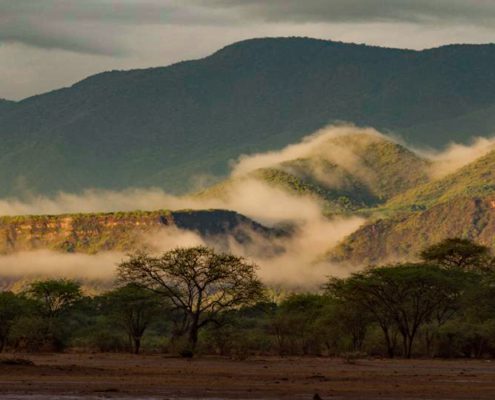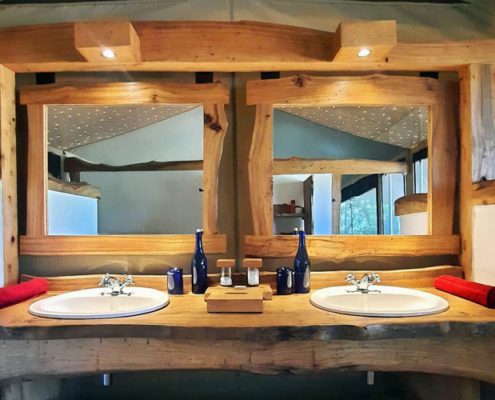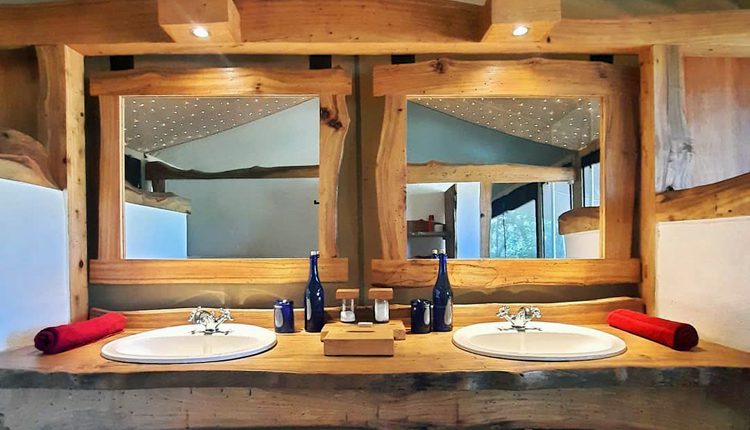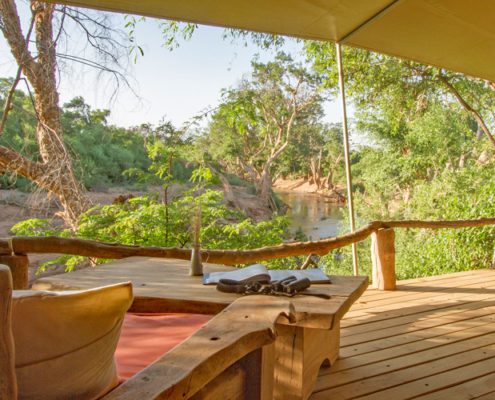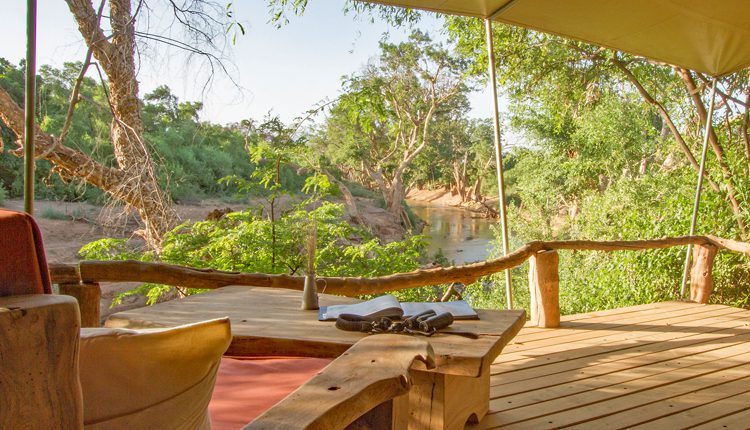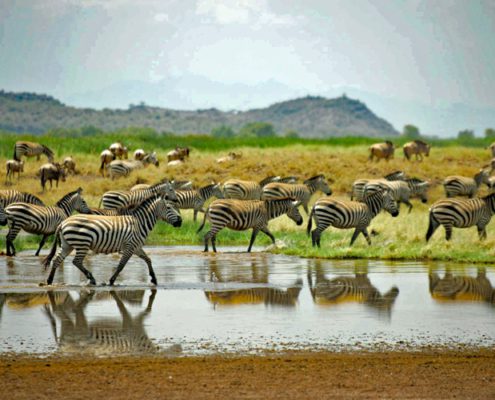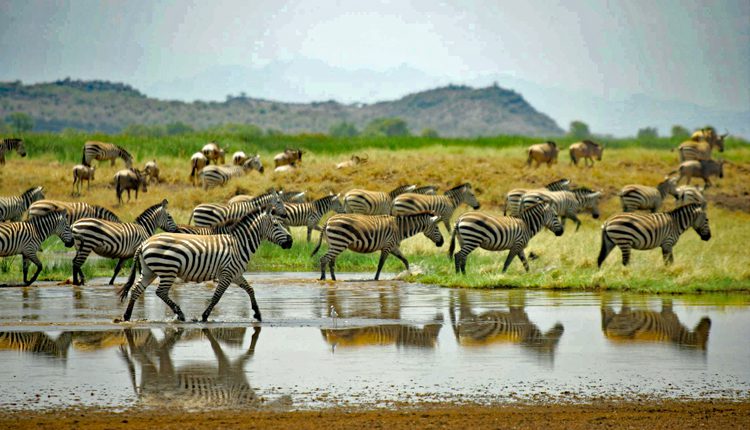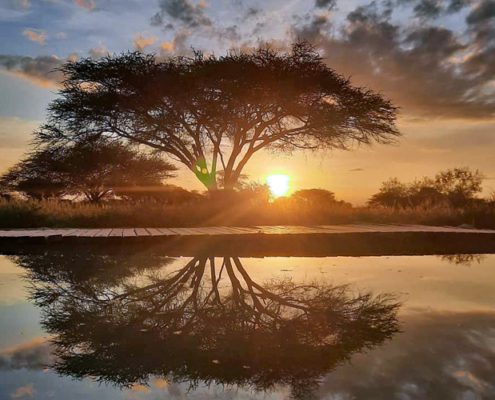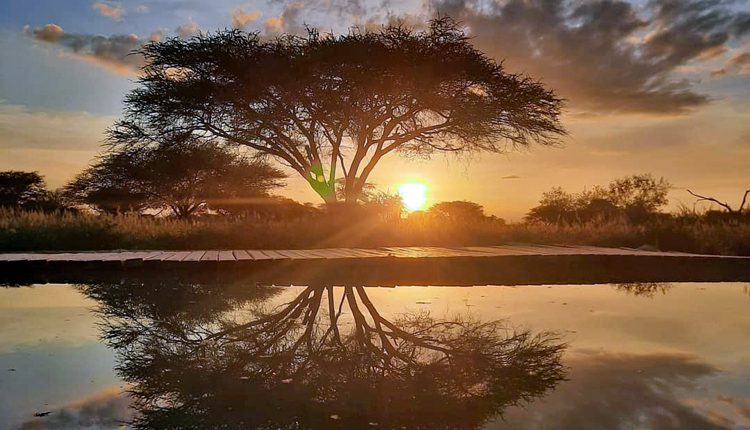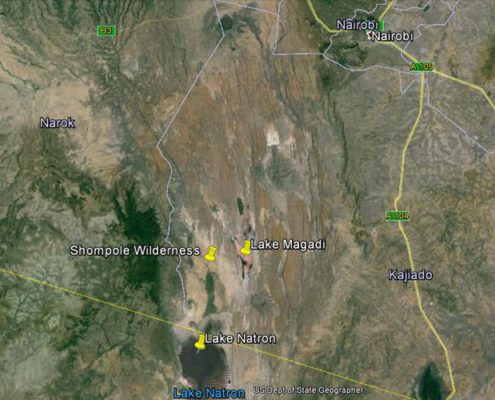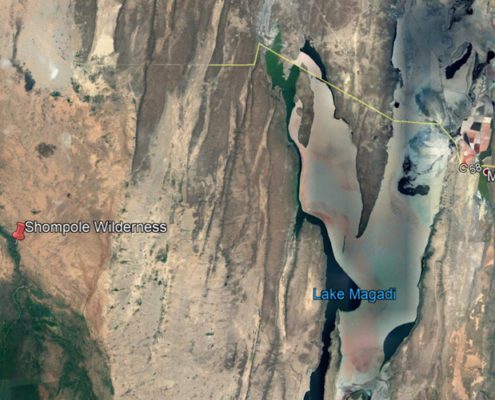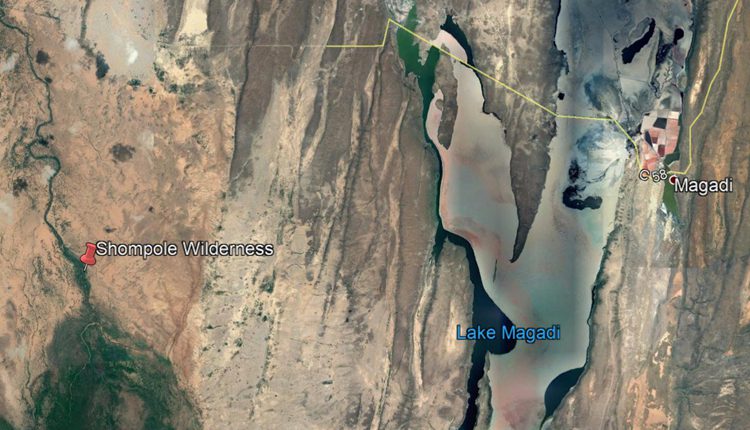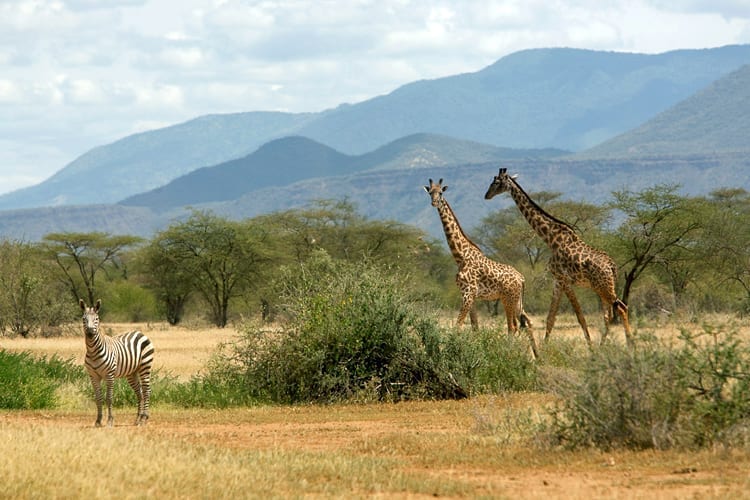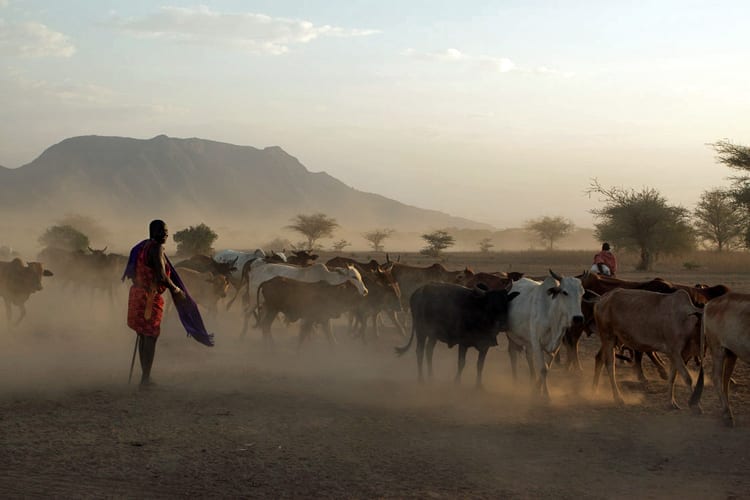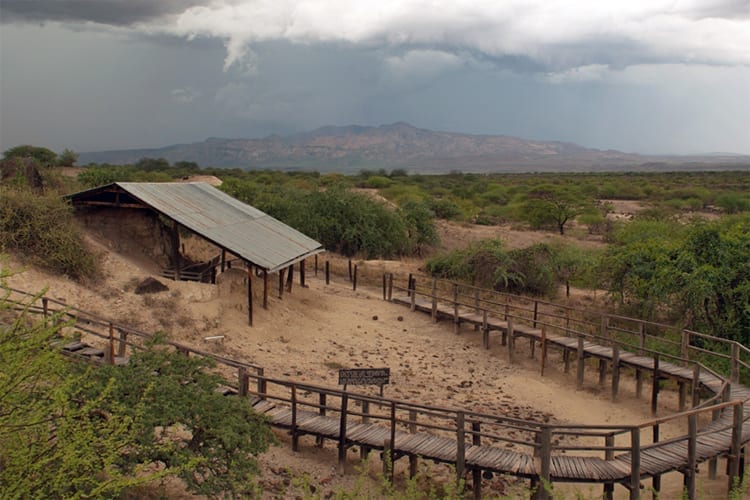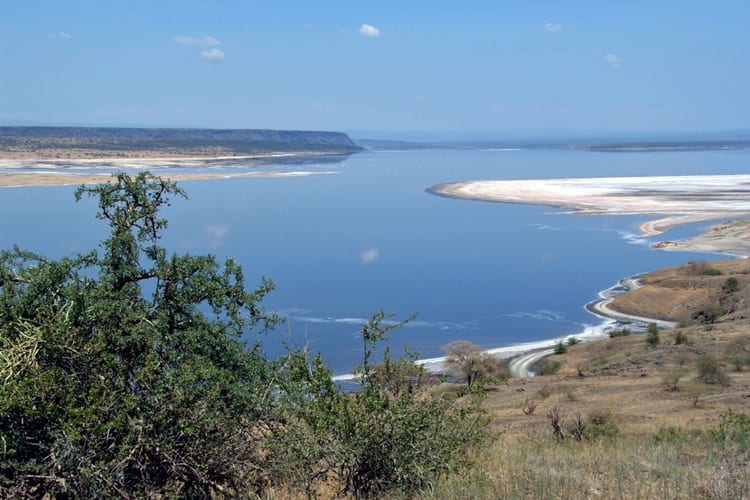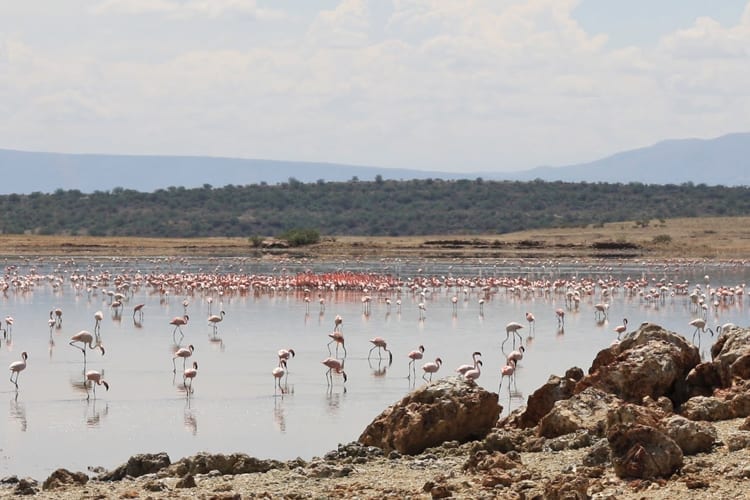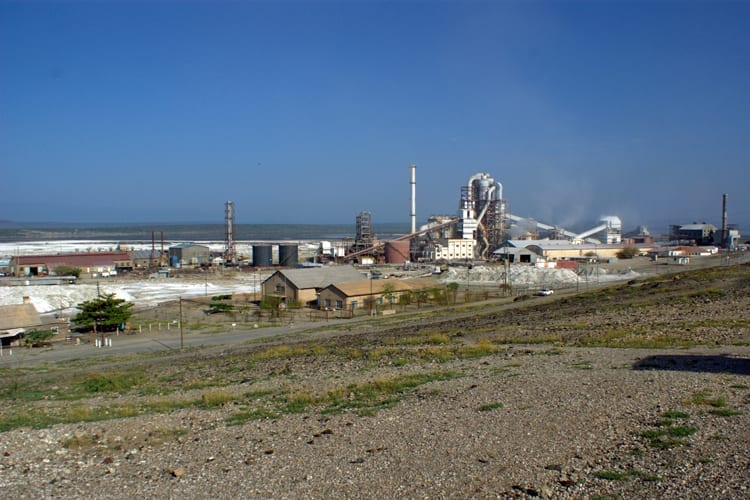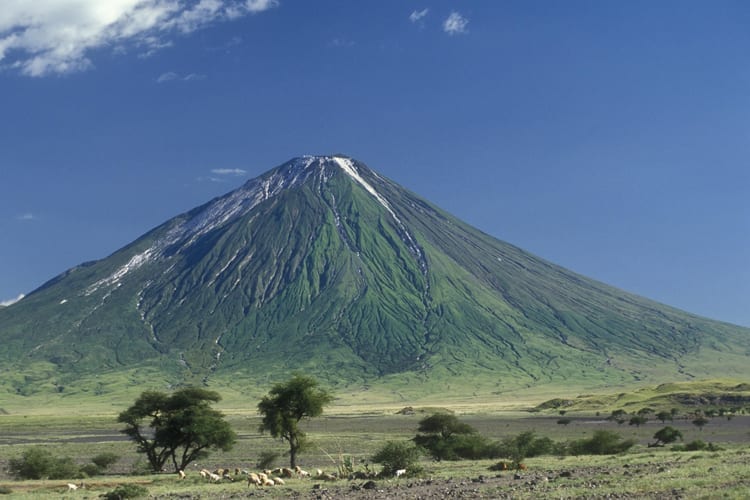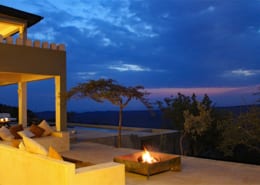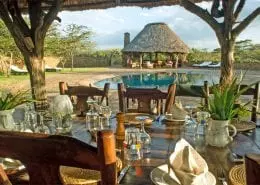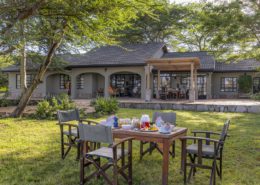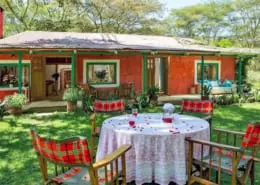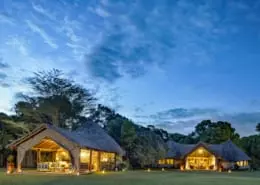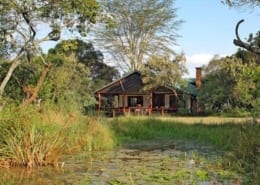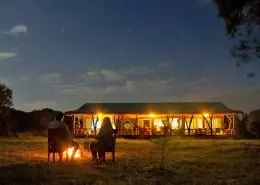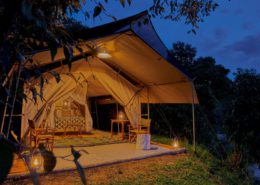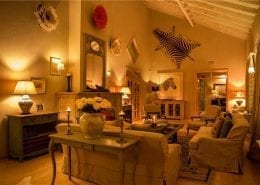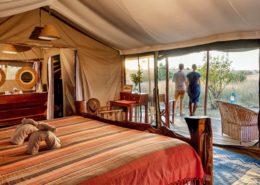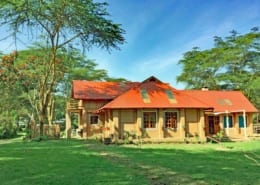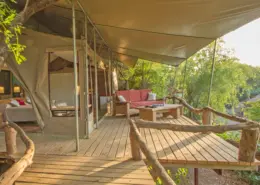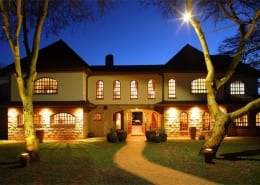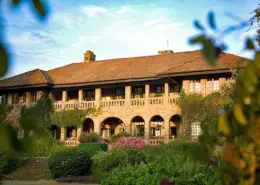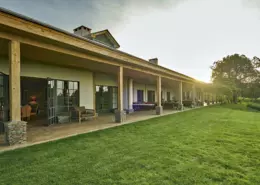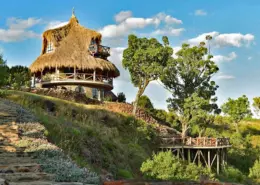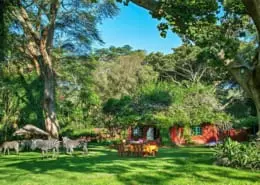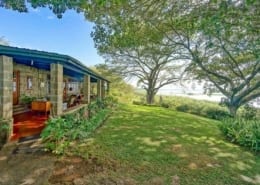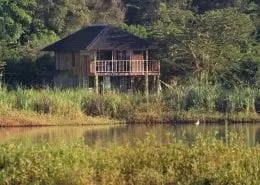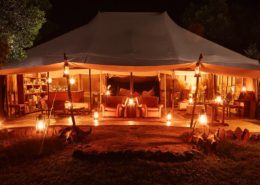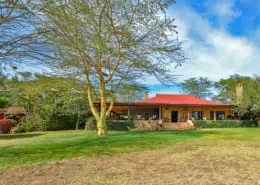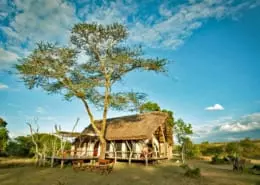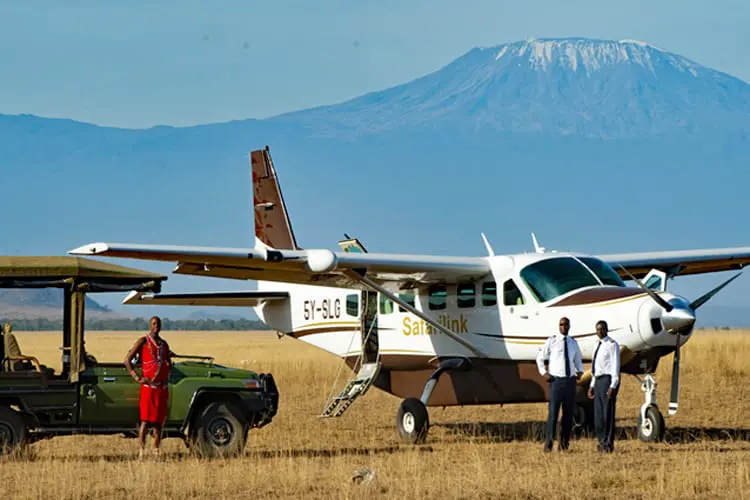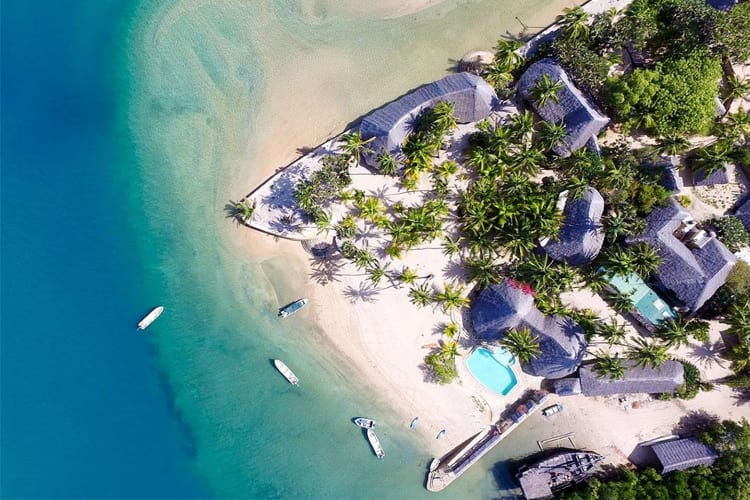Shompole Wilderness, Shompole Conservancy, Lake Magadi
An intimate and luxurious private safari camp with abundant wildlife set in a remarkable, remote and little-visited corner of Kenya, Shompole Wilderness nestles in a shady grove of giant fig trees on the banks of the Ewaso Ngiro River at the bottom of the Great Rift Valley.
For anyone looking to get right off the beaten track and spend time in a very special, wild and authentic part of East Africa, Shompole Conservancy, situated in the beautiful and unspoilt heart of Maasai land, is the ideal destination. And a stay at Shompole Wilderness camp means that guests can experience life in this fascinating part of the region in total privacy and real comfort.
The camp has just six luxurious and spacious double bedroom tents set on raised wooden decks with large verandas, all set out amidst bush and spreading fig trees on the banks of the Ewaso Ngiro (‘brown river’), the main source of water for the region, which flows from Kenya’s Mau escarpment into Tanzania’s Lake Natron around 25 kilometres south of the camp.
The tents are all private and well-spaced – each has an ensuite bathroom with shower and flushing lavatory, as well as solar-powered lights and fan. New for 2021 is a lovely swimming pool with shady bar and lounge area, plus riverside lounge and bar and separate airy dining room. Guests always comment on the delicious meals conjured up from the camp kitchen.
“It was just perfect! A beautiful location, superb food, quaint tents, amazing landscape, game drives and sundowners, chilled kayaking and walking, professional hosts and great and friendly staff. It’s a perfect place to stay for a weekend (or longer) getaway from Nairobi. I will definitely recommend it and definitely come back again for sure. Thank you all so much.”
Lianne, Nairobi
Wildlife is abundant in this relatively unknown corner of Kenya, with only Rhino missing from the diverse ecosystem. Animal numbers are increasing all the time – there are around forty lions, a resident cheetah mother with her four cubs, and leopard too. Elephants are back in the area after many years of absence, and can often be seen early in the morning making their way down to the river to drink.
Large herds of buffalo have been seen and there is a greater density of giraffe than almost anywhere in the region, along with abundant plains game such as zebra, wildebeest, impala and eland, and desert antelope such as gerenuk and oryx. The nocturnal wildlife viewing is good – with many small carnivores to be seen including bat-eared foxes, African wild cats, genet cats and even the shy caracal making an occasional appearance.
Research has shown over four hundred species of birds in the ecosystem, making this a must-visit location for bird lovers. Nearby soda lakes Natron and Magadi are rich in trona, attracting both the beautiful lesser and greater flamingos.
“A photographer’s paradise, an escapist’s utopia, beautiful and wild. We were lucky enough to stay in this lovely camp, hidden away from the rest of the world by a beautiful river, where the service was attentive and genuinely kind, and the food cooked in a camp kitchen was divine.”
Linda, Ireland
What makes this area particularly special and unique, however, is the fact that the wildlife lives alongside the Maasai and their livestock. The local Loodokilani Maasai, like their kinsmen throughout the region, tolerate wild game including large carnivores such as lions and leopards. As a result their homeland still resembles the pristine Africa of old, with a co-existence between man and beast which is increasingly rare in the region.
Your welcoming and knowledgeable hosts at the camp are the local Maasai together with Johann du Toit and his family, who have lived and worked in the area for over ten years. Johann is a Swiss-trained hotelier and safari guide and his wife Samantha heads up all the scientific research in the ecosystem. They have two small children Seyia and Taru living in the bush with them.
As well as game drives around the conservancy (self-drive with guide), all set against the backdrop of the magnificent Mount Shompole and the spectacular Great Rift Valley wall, other interesting things to do by vehicle are to visit the Shompole swamps, Lakes Magadi and Natron, nearby waterfalls and to do some tracking (both on foot and by vehicle).
Other recommended activities include :-
Tubing & Kayaking – the Ewaso Ngiro River is free of dangerous predators such as hippos and crocodiles – making it safe for swimming and kayaking – and floating down the river in an inner tube is a unique way to travel when the river is medium to low in level. You pass by huge fig tree roots going into the water, watched by while baboons and monkeys and the occasional monitor lizard.
Walking with Baboons – the nearby Lale’enok Resource Centre, a short drive up-river from the camp, is the base for the Walking with Baboons programme. Arriving first thing in the morning before the baboons leave their sleeping site, guests are accompanied by Sisco or Joel, the local Maasai baboon experts, and walk with the baboons and learn how they live and interact with each other
Walking with Cattle – travel across the plains with the local Maasai herders as they make their way back home with their cows after a long day’s grazing. Guests come closer to wildlife than usual amidst the cattle and can try to learn the whistles and chants the Maasai use to communicate with their precious cows.
Cultural Visits – with few outside influences the life of the Maasai here remains relatively traditional and unchanging. Guests can visit a Maasai Engang (settlement) and discover more about their customs and way of life.
Summary
- A lovely and very private owner-managed camp
- Six spacious and luxurious ensuite river-view tents
- Airy living, dining and bar areas, swimming pool
- Shompole Conservancy is a beautiful, private and little-known gem
- Excellent game viewing, day and night game drives
- Maasai cultural visits, walking with Maasai herdsmen, walking with baboons
- Kayaking and tubing on the lovely (and crocodile-free) Ewaso Ngiro River
- Standard resident accommodation rate Ksh 25,000 per adult sharing per night on a full board and self-drive basis
Detailed Information
- 6 luxury decked double tents with spacious verandas
- Ensuite bathrooms with hot showers and flush lavatories
- Solar lighting and electric fans in tents
- Swimming pool with shady bar and lounging area
- Riverside living room with bar and library
- Airy dining room and riverside lawns
- Delicious full-board accommodation
- Cash bar available
- Charging facility for cameras / phones
- Weak cell phone signal
- No wifi internet
- Laundry service available
- Guided game drives in guests’ vehicles
Location
Shompole Group Ranch, of which Shompole Conservancy is a part, lies on the floor of the Great Rift Valley close to the Kenya / Tanzania border. It embraces majestic plains, volcanic mountains and lush green wetlands, and is bordered by Lake Magadi to the east, Lake Natron to the south, the Nguruman Escarpment to the west and Olkiramatian Group Ranch to the north.
This lush grassland of the ranch, set amidst a semi-arid savannah, abounds with wildlife and livestock. The Shompole Ranch is an important migratory corridor and dispersal range for wildlife resident in the Nguruman Escarpment and Olkiramatian, including elephants which migrate between Shompole and Loita Hills. The area is one of the biodiversity hot spots in the South Rift region, lying between greater ecosystems of international importance – the Maasai Mara National Reserve and Amboseli National Park.
The 20,000 acre Shompole Conservancy was set up in the early 2000s, with the main aim of keeping the area as a ‘grass bank’ for cattle in times of severe drought. The area also acts as the same grazing refuge for the wildlife to such an extent that the ecosystem now hosts one of the highest densities of giraffe in Kenya.
The drive to the camp and conservancy from Nairobi down the escarpment and into the Rift Valley and Maasailand is a dramatic one. One recommended stop on the road to Magadi is the Olopelos Country Club – a highly regarded nyama choma joint with spectacular Rift Valley views.
The Olorgesailie Prehistoric Site is Kenya’s most important and largest archaeological and geological site, covering 21 hectares. It is located off the Magadi Road around 60 km from central Nairobi. It was discovered in 1919 by geologist JW Gregory and excavated further in the 1940s by Mary and Louis Leakey. The remains of many prehistoric animals have been uncovered as well as tools and axes used by early humans. The site is run by the National Museums of Kenya and has a small museum, guided tours, picnic and camp site and bandas.
Lake Magadi is the southern-most and lowest of Kenya’s Rift Valley lakes and covers an area of 104 square km (40 square miles). A vision in pink, it is a saline, alkaline lake, formed and constantly supplied by volcanic hot springs which get as hot as 80 degrees Celsius. Its thick crust of carbonate soda is removed by a floating dredge and pumped into refineries, where it is processed into soda ash which is used in glass making.
During the dry season the lake is 80% covered by soda and in some places the salt is up to 40 metres thick. During the rainy season, a thin layer of brine coats the lake, although this evaporates quickly, leaving a vast expanse of cracked white salt. The lake is also home to wading birds including flamingos. Magadi town on the East lake shore is home to the Magadi Soda Factory, which is the major local employer. There is basic shopping along with a petrol station in Magadi town.
Lake Natron is a large salt and soda lake in the Gregory Rift region of the Great Rift Valley of northern Tanzania, situated just across the border from Kenya and the Shompole Conservancy. The lake is dominated by Ol Doinyo Lengai, ‘The Mountain of God” in the Maasai language, an active volcano which uniquely produces natrocarbonatite lava. The lake is home to over 2 million Lesser Flamingos – 25% of the world population.
How to get there
By Road
Lake Magadi is only about 100 kilometres from central Nairobi and the journey to the lake should take you 2 ½ – 3 hours.
The C58 – known as Magadi Road – runs all the way to the lake from Langata Road at Bomas of Kenya / Galleria Mall – this route takes you through the towns of Ongata Rongai and Kiserian. Kiserian is also accessible from Karen via Ngong town.
Beyond Kiserian the road descends dramatically into the Rift Valley at Corner Baridi. From here on the road surface is poor in places and a 4-wheel drive is vehicle is essential – as it is for the murram roads beyond Lake Magadi and in the conservancy.
The conservancy and camp are accessed via the causeway that runs across Lake Magadi behind the soda factory. From Magadi Town it is approximately 25 km to the camp via the small settlement of Olkiramatian.
We will send you detailed directions of how to get to the camp – it is also recommended that you hire a Maasai guide in Olkirimatian to show you the way.
By Air
There is an airstrip 10 kilometres to the north of the camp near the research centre and Olkiramatian / Ngurumani bridge called RANGERS AIRSTRIP (Latitude -1844083 Longitude – 36.105917 (2,218ft)).
It is 1,300 meters long, dirt and pretty much an all-weather strip. Several charter companies use the strip. Some of them are Scenic Air Safaris, Boskovitch and Yellow Wings.
Visitor’s Book
“The tents are very comfortable with fabulous toiletries and stunning views right on the river’s edge. At night you can hear the lions calling which is a magical experience. The staff were amazing – very friendly and always at hand to help out wherever they could. Sam and Johann are great hosts and entertainers! Johann showed our group all sorts of interesting things… I won’t give it all away as it worth personally seeing all the lovely surprises he has in store… The food was exceptional! We were stuffed after every meal and what better way to work off the calories than with a bush walk and better still the tubing and kayaking was an experience second to none…we will definitely be going back again…and again!”
LSV, Nairobi
“A photographer’s paradise, an escapist’s utopia, beautiful and wild. We were lucky to stay in this lovely camp, hidden away from the rest of the world by a beautiful river where the service was attentive and genuinely kind, the food cooked in a camp kitchen was divine. Our hosts were extremely knowledgeable and passionate about the local culture and diverse wildlife, and the inclusion of the local people is an innovative and ethical way of running a business in the African wilderness. Do not miss a chance to tube down the river back into camp for sundowners and bitings. Breathtaking.”
Linda, Ireland
“We booked Shompole Wilderness over Christmas for a group of us including several children. The trip was sensational and the amazing variety of options kept us entertained for the full 3 nights we were there. The kids absolutely loved tubing down the river and mud sliding down the rivers banks. Game viewing was not as prolific as the Maasai Mara, however the one-on-one sightings and complete privacy offered made this a really great wildlife destination. Our hosts during the stay were Johann and Sam and their lovely kids who could not have been more professional and helpful throughout our stay. We would not hesitate to recommend this camp to anyone looking for something really special off the beaten track.”
GK, Nairobi
Rates
Low Season – 16th Jan to 31st May & 1st Oct to 14th Dec
- Resident adult – Ksh 25,000 per person sharing per night
- Resident child (3-12 years) – ksh 12,250 per child sharing per night
High Season – 1st Jun to 30th Sep & 15th Dec to 15th Jan
- Resident adult – Ksh 28,000 per person sharing per night
- Resident child (3-12 years) – ksh 14,000 per child sharing per night
Resident Conservancy and Community Fees
- Per resident adult – Ksh 3,000
- Per resident child (3-12 years) – Ksh 1,500
- Fees are per 24-hour period
Maximum occupancy – 12 guests
Minimum stay – 2 nights
Infants (2 years and below) stay free of charge
Single supplement applies for sole occupancy in a tent, at an additional 30% of the adult sharing rate
Rates are on a full board and self-drive basis including all meals, laundry, river activities, guided walks, use of
a guide on a self-drive game drive and shared use of the Shompole Hide
Alcoholic and other drinks – bring your own or purchase at the camp bar
Game drives are on a self-drive basis including the services of an in-car guide
Activities available at an additional cost – cultural/village visits, walking with baboons and helicopter flights
River activities are subject to height of river
Check-in from 11am and check-out by 9am
These rates, terms and conditions are valid for stays until 15th January 2025
The above rates are for East African Residents – please contact us for non-resident rates
Please contact us to make a booking
Please familiarise yourself with all our terms & conditions when making a booking

